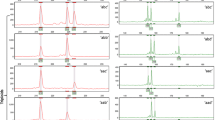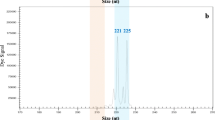Abstract
Sexual polyploidisation is one of the appropriate approaches in poplar breeding. Controlled pollinations were carried out with spontaneously formed, as well as induced, 2n gametes. Among the offspring individuals, 36 triploid plants and 1 tetraploid individual were detected by flow cytometry. The parental clones and all polyploid offspring individuals were genotyped by 18 nuclear microsatellite markers. The allelic configurations, especially tri-allelic patterns, and dosage effects were used to recognise diploid contributions of the male or female gamete. Three out of 18 markers localised near the centromeres of linkage groups I, X and XV. They are assumed to be unaffected by crossing over events and, therefore, able to ascertain the mechanism of first division restitution (FDR) or second division restitution (SDR) to generate diploid gametes. The applied three unlinked centromere-associated microsatellite markers allow a very effective determination of FDR resp. SDR processes. Altogether, 21 diploid pollen (10 FDR and 11 SDR) and 13 diploid ovules (1 FDR and 12 SDR) as well as 2 cases of postmeiotic reconstitution were determined with no inconsistency for the three markers. A female hybrid aspen clone (Populus tremula × Populus tremuloides) was assured to be able to frequently spontaneously form diploid ovules by the SDR mechanism. The transferred average heterozygosity in FDR gametes was assessed to be remarkably higher than that in SDR gametes. However, a selective inducement to favour FDR gametes seems not to be feasible with the current thermo-treatment techniques.

Similar content being viewed by others
References
Bradshaw HD, Stettler RF (1993) Molecular genetics of growth and development in Populus. I. Triploidy in hybrid poplars. Theor Appl Genet 86:301–307. doi:10.1007/bf00222092
Brownfield L, Köhler C (2011) Unreduced gamete formation in plants: mechanisms and prospects. J Exp Bot 62:1659–1668. doi:10.1093/jxb/erq371
Cai X, Xu SS (2007) Meiosis-driven genome variation in plants. Curr Genom 8:151–161
Cuenca J, Froelicher Y, Aleza P, Juarez J, Navarro L, Ollitrault P (2011) Multilocus half-tetrad analysis and centromere mapping in citrus: evidence of SDR mechanism for 2n megagametophyte production and partial chiasma interference in mandarin cv ‘Fortune’. Heredity 107:462–470. doi:10.1038/hdy.2011.33
De Storme N, Geelen D (2013) Sexual polyploidization in plants—cytological mechanisms and molecular regulation. New Phytol 198:670–684. doi:10.1111/nph.12184
De Storme N, Copenhaver GP, Geelen D (2012) Production of diploid male gametes in Arabidopsis by cold-induced destabilization of postmeiotic radial microtubule arrays. Plant Physiol 160:1808–1826. doi:10.1104/pp. 112.208611
Dewitte A, Van Laere K, Van Huylenbroeck J (2012) Use of 2n gametes in plant breeding. In: Abdurakhmonov IY (ed) Plant breeding. Agricultural and Biological Sciences. pp 59–86. doi: 10.5772/29827
Dong C-B, Suo Y-J, Kang X-Y (2014) Assessment of the genetic composition of triploid hybrid Populus using SSR markers with low recombination frequencies. Can J Forest Res:692–699 doi: 10.1139/cjfr-2013-0360
Dumolin S, Demesure B, Petit RJ (1995) Inheritance of chloroplast and mitochondrial genomes in pedunculate oak investigated with an efficient PCR method. Theor Appl Genet 91:1253–1256. doi:10.1007/BF00220937
Esselink GD, Nybom H, Vosman B (2004) Assignment of allelic configuration in polyploids using the MAC-PR (microsatellite DNA allele counting—peak ratios) method. Theor Appl Genet 109:402–408. doi:10.1007/s00122-004-1645-5
Ewald D, Ulrich K (2012) In vitro pollination in poplar of section Populus. Plant Cell Tiss Organ Cult 111:255–258. doi:10.1007/s11240-012-0189-7
Ewald D, Ulrich K, Naujoks G, Schröder MB (2009) Induction of tetraploid poplar and black locust plants using colchicine: chloroplast number as an early marker for selecting polyploids in vitro. Plant Cell Tiss Organ Cult 99:353–357. doi:10.1007/s11240-009-9601-3
Ewald D, Ulrich K, Liesebach H (2012) Erzeugung triploider Individuen und intersektioneller Hybriden bei verschiedenen Pappelarten. In: Züchtung und Ertragsleistung schnellwachsender Baumarten im Kurzumtrieb - Erkenntnisse aus drei Jahren FastWOOD, ProLoc und Weidenzüchtung, Hann. Münden. Beiträge aus der Nordwestdeutschen Forstlichen Versuchsanstalt, pp 183–193
Ferrante S, Lucretti S, Reale S, Patrizio A, Abbate L, Tusa N, Scarano M-T (2010) Assessment of the origin of new citrus tetraploid hybrids (2n =4x) by means of SSR markers and PCR based dosage effects. Euphytica 173:223–233. doi:10.1007/s10681-009-0093-3
Jackson N, Sanchez-Moran E, Buckling E, Armstrong SJ, Jones GH, Franklin FCH (2006) Reduced meiotic crossovers and delayed prophase I progression in AtMLH3-deficient Arabidopsis. EMBO J 25:1315–1323. doi:10.1038/sj.emboj.7600992
Johnsson H (1945) The triploid progeny of the cross diploid x tetraploid Populus tremula. Hereditas 31:411–440. doi:10.1111/j.1601-5223.1945.tb02761.x
Johnsson H, Eklundh C (1940) Colchicine treatment as a method in breeding hardwood species. Svensk Papperstidning 43:337–373
Kang X-Y, Zhu Z-T, Zhang Z-Y (2000) Breeding of triploids by the reciprocal crossing of Populus alba × P. glandulosa and P. tomentosa × P. bolleana. J Beijing For Univ 22:8–11
Kohl KP, Sekelsky J (2013) Meiotic and mitotic recombination in meiosis. Genetics 194:327–334. doi:10.1534/genetics.113.150581
Li YH, Kang X-Y, Wang SD, Zhang ZH, Chen HW (2008) Triploid induction in Populus alba × P. glandulosa by chromosome doubling of female gametes. Silv Genet 57:37–40
Liesebach H, Schneck V, Ewald E (2010) Clonal fingerprinting in the genus Populus L. by nuclear microsatellite loci regarding differences between sections, species and hybrids. Tree Genet Genomes 6:259–269. doi:10.1007/s11295-009-0246-5
Liesebach H, Naujoks G, Ewald D (2011) Successful hybridisation of normally incompatible hybrid aspen (Populus tremula × P. tremuloides) and eastern cottonwood (P. deltoides). Sex Plant Reprod 24:189–198. doi:10.1007/s00497-010-0156-6
Liesebach M, Schneck V, Wolf H (2012) Züchtung von Aspen für den Kurzumtrieb (Aspen improvement for short rotation coppice). In: Züchtung und Ertragsleistung schnellwachsender Baumarten im Kurzumtrieb - Erkenntnisse aus drei Jahren FastWOOD, ProLoc und Weidenzüchtung, Hann. Münden. Beiträge aus der Nordwestdeutschen Forstlichen Versuchsanstalt, pp 73–90
Lu M, Zhang P, Kang X (2013) Induction of 2n female gametes in Populus adenopoda Maxim by high temperature exposure during female gametophyte development. Breed Sci 63:96–103. doi:10.1270/jsbbs.63.96
Lu M, Zhang P, Wang J, Kang X, Wu J, Wang X, Chen Y (2014) Induction of tetraploidy using high temperature exposure during the first zygote division in Populus adenopoda Maxim. Plant Growth Regul 72:279–287. doi:10.1007/s10725-013-9859-7
Mashkina OS, Burdaeva IM, Belozerova MM, V’Yunova LN (1989) A method of inducing diploid pollen in woody species. Lesovedenie 1:19–25
Mercier R, Grelon M (2008) Meiosis in plants: ten years of gene discovery. Cytogenet Genome Res 120:281–290. doi:10.1159/000121077
Müntzing A (1936) The evolutionary significance of autopolyploidy. Hereditas 21:363–378. doi:10.1111/j.1601-5223.1936.tb03204.x
Nemorin A, David J, Maledon E, Nudol E, Dalon J, Arnau G (2013) Microsatellite and flow cytometry analysis to help understand the origin of Dioscorea alata polyploids. Ann Bot 112:811–819. doi:10.1093/aob/mct145
Peloquin SJ, Boiteux LS, Simon PW, Jansky SH (2008) A chromosome-specific estimate of transmission of heterozygosity by 2n gametes in potato. J Hered 99:177–181. doi:10.1093/jhered/esm110
Ramanna MS, Jacobsen E (2003) Relevance of sexual polyploidization for crop improvement—a review. Euphytica 133:3–8. doi:10.1023/A:1025600824483
Seitz FW (1954) The occurrence of triploids after self-pollination of anomalous androgynous flowers of a grey poplar. Z Forstgenet 3:1–6
Tuskan GA et al (2006) The genome of black cottonwood, Populus trichocarpa (Torr. & Gray). Science 313:1596–1604. doi:10.1126/science.1128691
Ulrich K, Ewald D (2014) Breeding triploid aspen and poplar clones for biomass production. Silv Genet 63:47–58
Vining K et al (2012) Dynamic DNA cytosine methylation in the Populus trichocarpa genome: tissue-level variation and relationship to gene expression. BMC Genomics 13:27. doi:10.1186/1471-2164-13-27
Wang J, Kang X-Y, Li D-L, Chen H, Zhang P (2010) Induction of diploid eggs with colchicine during embryo sac development in Populus. Silv Genet 59:40–48
Wang J, Kang X-Y, Li D-L (2012) High temperature-induced triploid production during embryo sac development in Populus. Silv Genet 61:85–93
Xi XJ, Jiang XB, Li D, Guo LQ, Zhang JF, Wei ZZ, Li BL (2011) Induction of 2n pollen by colchicine in Populus × popularis and its triploids breeding. Silv Genet 60:155–160
Yang S, Lu L, Ni Y (2006) Cloned poplar as a new fibre resource for the Chinese pulp and paper industry. Pulp Pap Can 107:34–37
Yao H, Dogra Gray A, Auger DL, Birchler JA (2013) Genomic dosage effects on heterosis in triploid maize. PNAS 110:2665–2669. doi:10.1073/pnas.1221966110
Yin T, DiFazio SP, Gunter LE, Riemenschneider D, Tuskan GA (2004) Large-scale heterospecific segregation distortion in Populus revealed by a dense genetic map. Theor Appl Genet 109:451–463. doi:10.1007/s00122-004-1653-5
Younis A, Hwang Y-J, Lim K-B (2014) Exploitation of induced 2n-gametes for plant breeding. Plant Cell Rep 33:215–223. doi:10.1007/s00299-013-1534-y
Zhang Z, Kang X-Y (2010) Cytological characteristics of numerically unreduced pollen production in Populus tomentosa Carr. Euphytica 173:151–159. doi:10.1007/s10681-009-0051-0
Zhang ZY, Li FL, Zhu ZT (1992) Chromosome doubling and triploid breeding of Populus tomentosa Carr. and its hybrid. J Beijing For Univ 14(Suppl):52–58
Zhang J-F, Wei Z-Z, Li D, Li B (2009) Using SSR markers to study the mechanism of 2n pollen formation in Populus × euramericana (Dode) Guinier and P. × popularis. Ann For Sci 66:506. doi:10.1051/forest/2009032
Zhu Z, Kang X, Zhang Z (1998) Studies on selection of natural triploids of Populus tomentosa. Sci Silvae Sin 34:22–32
Acknowledgments
We thank Prof. Yang Minsheng (Agricultural University of Hebei, China) for providing Populus simonii pollen, Mr. Volker Schneck (Thünen Institute of Forest Genetics Waldsieversdorf) for providing some spontaneously generated triploids poplar plants, Ms. Elke Ewald for laboratory assistance in genotyping and Ms. Dina Führmann for language editing. We also thank the anonymous reviewers for their helpful comments. This work was funded by the German Agency Renewable Resources (Fachagentur Nachwachsende Rohstoffe e.V. (FNR)).
Data archiving statement
A spreadsheet file in the form of marker/genotype data is provided as a supplementary material.
Author information
Authors and Affiliations
Corresponding author
Additional information
Communicated by A. Brunner
Rights and permissions
About this article
Cite this article
Liesebach, H., Ulrich, K. & Ewald, D. FDR and SDR processes in meiosis and diploid gamete formation in poplars (Populus L.) detected by centromere-associated microsatellite markers. Tree Genetics & Genomes 11, 801 (2015). https://doi.org/10.1007/s11295-014-0801-6
Received:
Revised:
Accepted:
Published:
DOI: https://doi.org/10.1007/s11295-014-0801-6




